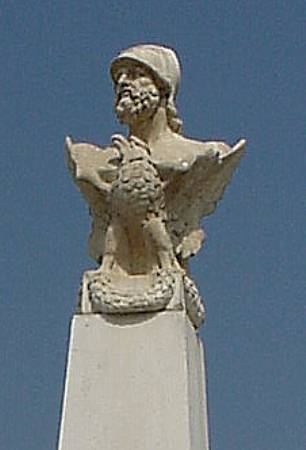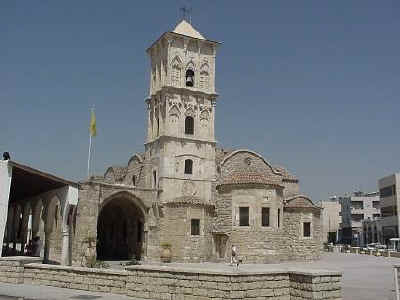 |
 |
 |
| Nicosia, the capital city of Cyprus, is divided between the
Greeks of the south and the Turks of the north. Our visit to the southern
coast of the island enabled us to visit Lefkosia, or South Nicosia, without
crossing the border. The Old City is surrounded by the remaining Venetian
walls, constructed between 1567 and 1570 to keep out the Ottomans. There
were eleven fortifying bastions and a moat. Months after the fort's
completion, in October 1570, the Ottomans successfully stormed the
fortifications and took over the city. So it wasn't such a strong fort, but
at least it's an attractive one.
You are looking through the Famagusta Gate, one of three entrances to the old city. Recently renovated, the city now uses the area for exhibitions, concerts and other public uses. |
|
| Legend says that the Greek goddess Aphrodite
was born in the waters off of Cyprus, emerging from a surge of sea foam.
She's the patron goddess of the island.
The story of Pygmalion and his statue takes place in Cyprus. Pygmalion, a woman-hater, carves a statue of a beautiful woman and falls in love with it. He kisses its stone lips, dresses it in lovely clothes, buys it expensive gifts, and tucks it into bed at night. Today, we'd have him arrested. But in mythology, he asks Aphrodite to find him a woman like his statue, but she brings the statue itself to life. |
|
 |
The Cypriots in the city of Kition (now Larnaca) sided with
the Persians in the Greek-Persian wars in the fifth century BC, and lost.
This statue gracing Larnaca's harbor promenade commemorates the Athenian
commander Kimon, who arrived in 450 BC. Unfortunately, he died before he
even got within the city walls.
In a clever and very early prequel to "Weekend at Bernie's", his underlings chose to suppress the news of Kimon's death from the army, issuing orders and pretending that they were coming from Kimon. They won the battle, and the inscription on this statue translates to something like "Even in death, he conquers." The philosopher Zenon was born in Larnaca and founded the school of Stoicism. The philosophy involves doing without material possessions and largely requires enduring suffering and eschewing pleasure. He died at 98 by his own hand. Perhaps he realized that he was too happy to live. |
| This is the Church of Lazarus, in Larnaca. Jesus is said to have raised Lazarus from the dead, and he fled to Larnaca, expelled by the Jews. He became the bishop of Larnaca and served for thirty years before he died again. First buried in Larnaca, his bones were moved to Constantinople in 890 and then to Marseille in 1204. |  |